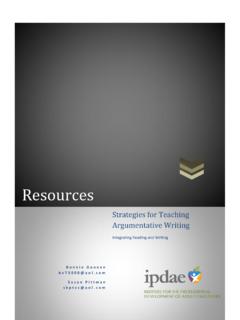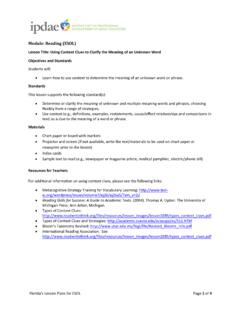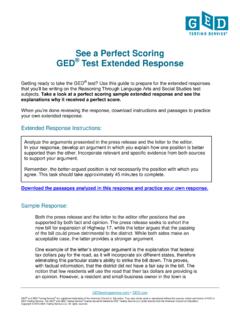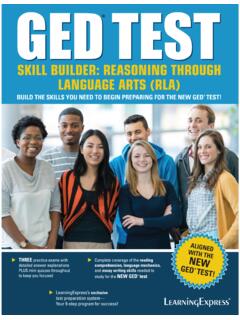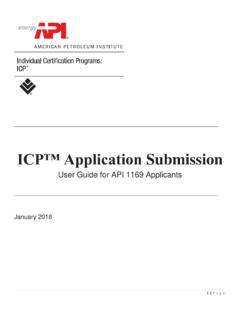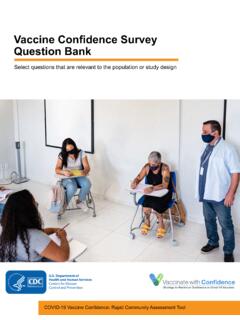Transcription of Strategies for Teaching Argumentative Writing
1 Resources B o n n i e G o o n e n b v 7 3 0 0 8 @ a o l . c o m S u s a n P i t t m a n s k p t v s @ a o l . c o m Strategies for Teaching Argumentative Writing Integrating Reading and Writing Page 1 of 17 Response 7 From the The 2014 GED Test Reasoning Through language Arts (RLA) Extended Response Resource guide for Adult Educators p. 18 Notes Although both positions are well organized and supported with several examples, the evidence supporting the view against DST is more specific and thorough.
2 The first position makes some valid points, ones that are sure to catch any reader's attention. The writer brings up expenses, safety, and crime rates, all of which are supposedly improved through the use of DST. However, the evidence he uses to support this claim seems general and outdated. In paragraph four, he mentions that one study took place in the 1970s. He also uses phrases such as "many studies" and "other studies." While the points he makes are interesting, there are no specifics. One is left wondering just how outdated or reliable these studies are, and if they even apply to the average American.
3 Had he used less generalized phrases, he may have sounded more convincing. The second position is much better supported, especially compared to the somewhat lacking arguments of the previous position. The writer's information is precise, and he seems to use more studies than the first author. While the first author used studies from the 1970s, this one mentions a study done in 2007. The specifics of each study also improve the quality and seeming validity of the arguments made. The writer gives the states in which the studies were conducted and the reasons why the researches believed they got those results.
4 Also, like the first author, the issues of which he writes are ones that will catch the reader's attention: energy consumption, safety, and confusion. While they are similar to those points brought up by the first writer, The Claim Is it debatable? Is the focus narrow enough for the Writing required? Does it establish the argument? Is it valid? The Evidence Does it support the claim? Does it include facts or statistics? Does it include examples? Is it based on an expert s or the writer s personal opinion?
5 The Warrant Does it explain the pieces of evidence? Does it connect evidence to the claim? Is it reasonable? Does it make assumptions? Is it logical? The Counterclaim Does the writer include information that disagrees with the original claim? Is it reasonable? What is the evidence that supports the counterclaim? Page 2 of 17 this second position is far better supported through its organization and attention to detail. The Rebuttal Does it explain why the counterclaim does not work? What is the evidence used to support the rebuttal?
6 Page 3 of 17 Looking at Structure Classic Model for an Argument No one structure fits all written arguments. However, Argumentative Writing consists of the following elements. Below is a basic outline for an Argumentative or persuasive essay. I. Introductory Paragraph Set up Your Claim Your introductory paragraph sets the stage or the context for the position for which you are arguing. The introduction should include a thesis statement that provides your claim (what you are arguing for) and the reasons for your position on an issue.
7 Your thesis: states what your position on an issue is usually appears at the beginning or ending of the introduction in a short essay should be clearly stated and should contain emphatic language (should, ought, must) II. Body of your Argument Support Your Claim A. Background Information Lays the foundation for proving your argument This section of your paper gives the reader the basic information he or she needs to understand your position. This section will often include: A summary of works being discussed A definition of key terms An explanation of key theories B.
8 Reasons or Evidence to Support your Claim All evidence you present in this section should support your position. This is the focus of your essay. Generally, you begin with a statement that you back up with specific details or examples. Make sure to connect the evidence to the claim. The reader should be able to see that there is a logical, persuasive connection between the claim, reasons, and data (evidence). Depending on how long your argument is, you will need to devote one to two well-developed paragraphs to each reason/claim or type of evidence.
9 Sample Format for Supporting Evidence Paragraph Topic Sentence: What is one item, fact, detail, or example you can tell your readers that will help them better understand your claim/paper topic? Your answer should be the topic sentence for this paragraph. Introduce Evidence: Introduce your evidence either in a few words (As Dr. Brown states ..) or in a full sentence (To understand this issue. we first need to look at statistics). State Evidence: What supporting evidence (reasons, examples, facts, statistics, and/or quotations) can you include to prove/support/explain your topic sentence?
10 Page 4 of 17 Explain Evidence: How should we read or interpret the evidence you are providing us? How does this evidence prove the point you are trying to make in this paragraph? Can be opinion based and is often at least 1-3 sentences. Concluding/Transitional Sentence(s): End your paragraph with a concluding sentence that reasserts how the topic sentence of this paragraph helps up better understand and/or prove your paper s overall claim and how it transitions to the next idea. III. Addressing the Opposite Side Refute the Objections Any well-written argument must anticipate and address positions in opposition to the one being argued.

